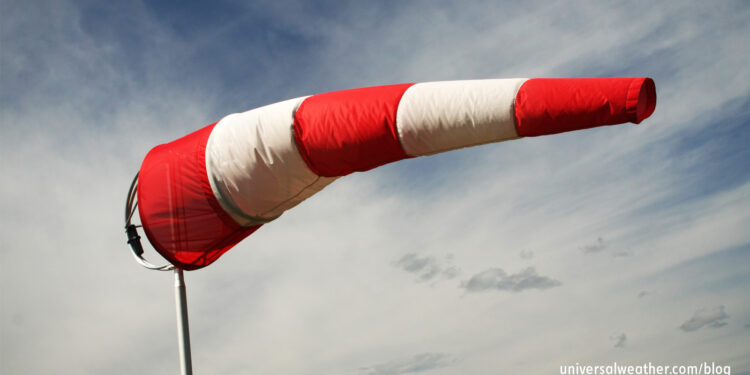Crosswinds and Their Effect on Flight – Part Two: Approach/Departure Impact

This business aviation blog post continues from our article last week, entitled “Crosswinds and Their Effect on Flight – Part One: Enroute Impacts.”
Last week, we discussed the enroute impacts of crosswinds. Today, we’ll discuss impacts on the other side of the trip: arrival and departure. As a general best practice, you should always work with an experienced aviation meteorologist to determine if crosswinds will be a factor during your intended operation and to ensure that you’re aware of runway surface conditions prior to operation.
The following is an overview of what you need to know:
1. Calculating crosswinds
There are tools available to assist crew members in computing crosswind components for arrival and departure, using magnetic headings of runways and projected surface winds. For arrivals and departures, crew members need current data on existing conditions and crosswinds components. Local observations and Terminal Area Forecasts (TAFs) are integral for determining conditions at the station, so it’s important to have up-to-date information on the day of flight. Surface conditions at many locations are observed hourly or randomly during the hour, to calculate winds. Crosswinds are typically calculated using station observations along with weather data models. While some locations do not provide their own TAFs, your 3rd-party provider can create a TAF if they have weather observations for the area. Over the last few years, we’ve seen more and more flights traveling to remote locations that do not publish TAFs.
2. Crosswinds may become an issue
Your aircraft manual will inform you on the maximum crosswinds your aircraft can safely handle. Factors to consider include the strength of the crosswind component, weight and size of your aircraft, and surface conditions (such as rain, ice, or snow) that may impact braking action. Note that surface conditions can vary quite a bit from one moment to the next at certain airports. Weather models usually provide reliable information regarding surface winds.
3. Maximum crosswind conditions
Larger General Aviation (GA) aircraft are not usually affected by crosswind components in the 10-20 knot range. Whenever forecast crosswinds are over 30 knots, however, you’ll want to take a closer look at local airport conditions. Aircraft manuals advise on safe crosswind component limits, but your company Standard Operating Procedures (SOPs) may also provide guidance on maximum crosswind component limits. Heavier aircraft landing on dry runway conditions can safely manage higher crosswind components than either lighter GA aircraft or aircraft landing on wet or icy runways.
4. Anomalies in surface winds
At some locations such as Reykjavik (BIRK) – due to local weather patterns and geography – surface winds are not always accurately forecasted. This may create a dilemma on arrival. Keflavik (BIKF) often experiences deep low-pressure conditions with accelerating surface winds running 25-29 knots sustained with gusts up to 50 knots. You’ll often experience frequent surface wind changes at both Nice (LFMN) and Marseille (LFML) due to mistral winds in the area. At times you’ll experience quite choppy lower-level and surface winds in the LFML area and may want to consider an alternate – such as Genoa (LIMJ) – outside the area.
5. Wake turbulence and surface winds
Wake turbulence is air turbulence coming off engines and wingtips that creates short-lived vortices. Depending on the size/weight of the departing aircraft, the next aircraft may need to wait one or two minutes prior to taking off. Excessive surface wind conditions, when combined with wake turbulence, have the potential to create a more dangerous situation and may require waiting a little longer before taking off.
6. Additional information and best practices
Check with your original equipment manufacturer/SOPs and review crosswind thresholds for your particular aircraft. Your 3rd-party provider and local ground handler will be able to provide more information on runway surface conditions, any local obstructions, and forecast runway surface conditions at time of anticipated operation. Additionally, many websites provide a generalized discussion on crosswinds, and the effects on air travel.
Conclusion
It’s rare to encounter crosswind components on arrival that are so extreme that they’ll limit your ability to safely land a larger GA aircraft. Higher crosswind conditions – 75 to 80% of the time – are the result of a front moving through and temporarily changing wind speed and direction. If you are faced with a significant crosswind component on approach, it’s always important to be briefed and aware of runway surface conditions and traction – an experienced aviation meteorologist can help.
Questions?
If you have any questions about this article or would like more information on crosswinds, contact me at davehoule@univ-wea.com.




